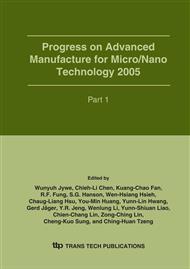p.775
p.781
p.787
p.793
p.799
p.805
p.811
p.817
p.823
Surface Finishing of Plastic Injection Mold Steel with Ball Burnishing and Spherical Polishing Processes on a Machining Center
Abstract:
This study investigates the possible ball burnishing and spherical polishing surface finish process of a freeform surface plastic injection mold on a machining center. The optimal plane polishing parameters were determined by utilizing the Taguchi’s orthogonal array method for plastic injection molding steel PDS5. Five polishing parameters, namely the speed of the polishing ball, abrasive material, feed, stepover distance and the depth of penetration were selected as the experimental factors of Taguchi’s Design of Experiment to determine the optimal plane polishing parameters, which have the dominant influence on surface roughness. The optimal plane polishing parameters have been determined after conducting the experiments of the Taguchi’s L18 orthogonal table. The optimal plane polishing parameters for the plastic injection mold steel PDS5 were the combination of the polishing speed 18,000 rpm, the abrasives of aluminum oxide (Al2O3) with grid no. 5000, the feed of 100 mm/min., stepover distance of 60μ m, and the depth of penetration of 240 μ m. The surface roughness Ra of the specimen can be improved from about 1.125μ m to 0.067μ m using the optimal ball burnishing parameters for plane burnishing. The surface roughness Ra of the burnished specimen can be further improved from about 0.067μ m to 0.023μ m using the optimal polishing parameters.
Info:
Periodical:
Pages:
799-804
Citation:
Online since:
January 2006
Authors:
Price:
Сopyright:
© 2006 Trans Tech Publications Ltd. All Rights Reserved
Share:
Citation:


